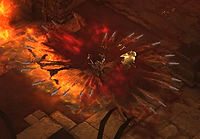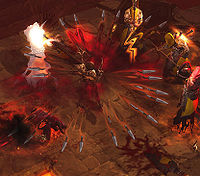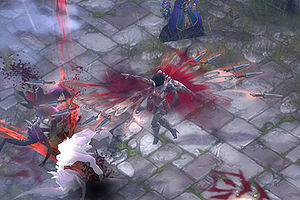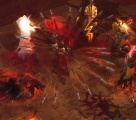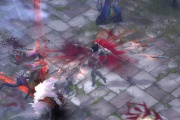Fan of Knives is a Hatred Spending Demon Hunter skill unlocked at level 14. The Demon Hunter quickly whips around in a full circle, sending out a nova of blades that hit all targets in range, many of them multiple times.
Contents
Background
The Demon Hunter magically summons a wealth of blades, distributing them in a spinning arc, damaging and slowing enemies within close-range, similar to the nova spells from Diablo of yore.
Skill Effects
The following is a very quick list. See the Fan of Knives rune effects page for a more thorough summary of rune effects, or any of the individual rune pages for numbers, screenshots, blue quotes, and much more.
| Icon | Skill | Description |
|---|
| |
Fan of Knives Hatred Spender (Level 14) |
[e] Cost: 20 Hatred Throw knives out in a spiral around you, doing 450% weapon damage to all enemies within 10 yards of you. Your knives will also slow the movement of enemies by 65% for 4 seconds. |
| Retaliate |
[e] Instead of throwing the knives immediately, the knives will release automatically dealing 336% weapon damage to all enemies if you are struck in the next 20 seconds. |
| Hail of Knives |
[e] Increase the radius to deal 336% weapon damage to all enemies within 18 yards. |
| Crippling Razors |
[e] Increase the slow amount to 79% for 4 seconds. |
| Assassin's Knives |
[e] Throw long-range knives that deal 85% weapon damage to 8 additional targets. |
| Fan of Daggers |
[e] Imbue your knives with a 20% chance to stun enemies for 3.5 seconds. |
Note: Information is based on a level 60 character and rank 7 runestones.
Fan of Knives Video
A video of Fan of Knives can be seen below, courtesy of the Diablo.IncGamers.com You Tube channel.
Skill Design
Fan of Knives is a short-range area-of-effect ability that damages all of the enemies in range of the skill. This type of skill is best used either when surrounded by enemies or within close quarters where the enemies are bunched together to a point where the skill will penetrate deeply into the group. The knives also include a slowing debuff.
Synergies
The following Demon Hunter passives provide a benefit to Fan of Knives, runed or not:
| {{{icon}}} | [[{{{name}}}]] | 30 | {{{desc}}} |
Development
Fan of Knives was first shown at BlizzCon 2010 as one of the originals when the Demon Hunter was unveiled. Flux gave it a whirl in the demo:[1]
The real limiting factor of this one is the very short range of the knives. They did good damage, but the range was barely beyond melee reach (not that the DH was using melee weapons), and it was fairly mana-expensive. As a result, this one was only worth using when you had at least two or three enemies at very close range. The perfect situation for it was a circle of Vessels, and I enjoyed killing all 6 or 8 Vessels in such scenarios several times with this skill. It took 2 or 3 FoKs to finish them all, but this was the fastest and most effective skill against those clusters of enemies in the entire demo.
Skill tiers were removed for the July 2011 Press Event, and Fan of Knives became a level 4 skill.
In Other Games
As many fans noticed upon announcement of the Demon Hunter and getting to see her skills for the first time, Fan of Knives is a returning skill from previous Blizzard games, namely WarCraft III and World of WarCraft. In WarCraft III, it was an ability used by the "Warden" hero character, and in World of WarCraft it is a level 80 ability used by the Rogue class. Fan of Knives appears to be making a niche within the Blizzard pool of spells and abilities, such as other spells like Teleport, and Blizzard.
Media
Fan of Knives can be seen in action on video here:
You can find pictures in the Diablo III screenshot and picture gallery:
References
- BlizzCon 2010 Demon Hunter PvM Hands-on Report
- Zediono's translation of JudgeHype's pre-beta report -- IncGamers 1st Aug 2011
- HardRock's Demon Hunter Skills and Their Rune Effects -- IncGamers 6th Sep 2011
- Demon Hunter Active Skills -- Diablo III 12th Sep 2011
| Classes of the Diablo games |
Skills - Active skills - Skill runes - Passives - Resource - Movement ability [e] Barbarian Demon Hunter Monk Necromancer Witch Doctor Wizard Followers Other Classes Fan-made |
|---|
| The Barbarian | Fury - Barbarian Active Skills (Archive) | Barbarian Passive Skills (Archive) [e] | |||
|---|---|---|---|---|---|
|
|
Primary Might |
Secondary Tactics |
Defensive Rage |
Pound of Flesh (10) |
Superstition (30) |
| (X) = the level at which the skill becomes unlocked. | |||||
| Barbarian skill categories: Primary Secondary Defensive Might Tactics Rage |
|---|
|
Bash |
Cleave |
Frenzy |
[e] |
|
Hammer of the Ancients |
Rend |
Seismic Slam |
Whirlwind |
[e] |
|
Ground Stomp |
Leap |
Sprint |
Ignore Pain |
[e] |
|
Ancient Spear |
Revenge |
Furious Charge |
Overpower |
[e] |
|
Weapon Throw |
Threatening Shout |
Battle Rage |
War Cry |
[e] |
|
Earthquake |
Call of the Ancients |
Wrath of the Berserker |
[e] |
| The Demon Hunter | Hatred/Discipline - Demon Hunter Active Skills (Archive) | Demon Hunter Passive Skills (Archive) [e] | |||
|---|---|---|---|---|---|
|
Primary attribute:
|
Primary Hunting |
Secondary Devices |
Defensive Archery |
Tactical Advantage (10) |
Archery (30) |
| (X) = the level at which the skill becomes unlocked. | |||||
| Demon Hunter skill categories: Primary Secondary Defensive Hunting Devices Archery |
|---|
|
Hungering Arrow |
Entangling Shot |
Bola Shot |
Grenades |
[e] |
|
Impale |
Rapid Fire |
Chakram |
Elemental Arrow |
[e] |
|
Caltrops |
Smoke Screen |
Shadow Power |
[e] |
|
Vault |
Preparation |
Companion |
Marked for Death |
[e] |
|
Evasive Fire |
Fan of Knives |
Spike Trap |
Sentry |
[e] |
|
Strafe |
Multishot |
Cluster Arrow |
Rain of Vengeance |
[e] |
| Monk skill categories: Primary Secondary Defensive Techniques Focus Mantras |
|---|
|
Fists of Thunder |
Deadly Reach |
Crippling Wave |
Way of the Hundred Fists |
[e] |
|
Lashing Tail Kick |
Tempest Rush |
Wave of Light |
[e] |
|
Blinding Flash |
Breath of Heaven |
Serenity |
Inner Sanctuary |
[e] |
|
Dashing Strike |
Exploding Palm |
Sweeping Wind |
[e] |
|
Cyclone Strike |
Seven-Sided Strike |
Mystic Ally |
[e] |
|
Mantra of Evasion |
Mantra of Retribution |
Mantra of Healing |
Mantra of Conviction |
[e] |
| Necromancer skill categories: Primary Secondary Corpses Blood and Bone Reanimation Curses |
|---|
| Witch Doctor skill categories: Primary Secondary Defensive Terror Decay Voodoo |
|---|
|
Poison Dart - Rune effects |
Corpse Spiders |
Plague of Toads |
Firebomb |
[e] |
|
Grasp of the Dead |
Firebats |
Haunt |
Locust Swarm |
[e] |
|
Summon Zombie Dogs |
Horrify |
Spirit Walk |
Hex |
[e] |
|
Soul Harvest |
Sacrifice |
Mass Confusion |
[e] |
|
Zombie Charger |
Spirit Barrage |
Acid Cloud |
Wall of Zombies |
[e] |
|
Gargantuan |
Big Bad Voodoo |
Fetish Army |
[e] |
| The Wizard | Arcane Power - Wizard Active Skills (Archive) | Wizard Passive Skills (Archive) [e] | |||
|---|---|---|---|---|---|
|
Primary attribute:
|
Primary Force |
Secondary Conjuration |
Defensive Mastery |
Blur (10) |
Conflagration (34) |
| (X) = the level at which the skill becomes unlocked. | |||||
| Wizard skill categories: Primary Secondary Defensive Force Conjuration Mastery |
|---|
|
Magic Missile |
Shock Pulse |
Spectral Blade |
Electrocute |
[e] |
|
Ray of Frost |
Arcane Orb |
Arcane Torrent |
Disintegrate |
[e] |
|
Frost Nova |
Diamond Skin |
Slow Time |
Teleport |
[e] |
|
Wave of Force |
Energy Twister |
Hydra |
Meteor |
Blizzard |
[e] |
|
Ice Armor |
Storm Armor |
Magic Weapon |
Familiar |
Energy Armor |
[e] |
|
Explosive Blast |
Mirror Image |
Archon |
[e] |
| Followers | Kormac the Templar | Lyndon the Scoundrel | Eirena the Enchantress [e] | |||
|---|---|---|---|---|---|---|
|
Level 10: |
Level 5: Level 10: |
Level 15: |
Level 15: Level 20: |
Level 25: Level 30: | ||
| Diablo III Other Classes | Diablo II Classes | Diablo I Classes [e] | ||||
|---|---|---|---|---|---|---|
|
Archetypes: |
Archetype sub-types: |
Other classes: |
Diablo II: |
|||
| Fan-made Classes | Fan-made Skills [e] | ||||
|---|---|---|---|---|---|
|
• Alchemist |
• Flagellant |
• Ranger |
Dragon Warrior Skills |
Aurian Mage Skill | |
| | |||||
